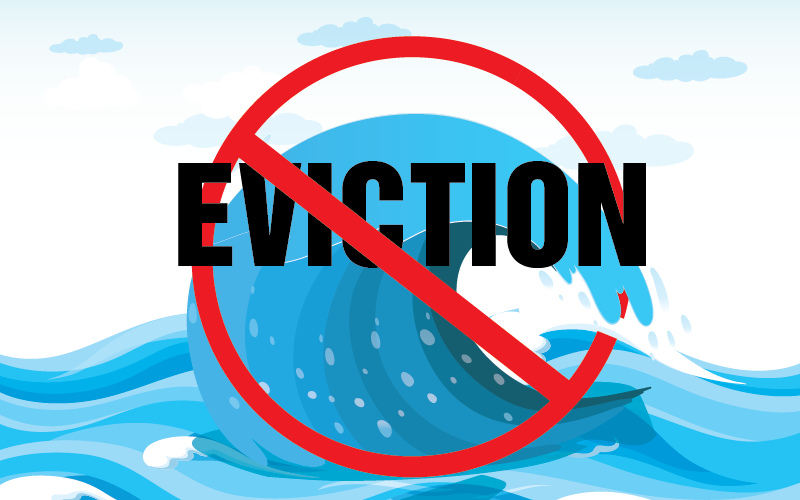Six Months Beyond the State Eviction Moratorium – No ‘Eviction Tsunami’
| . Posted in News - 0 Comments
By Eric Weld, MassLandlords, Inc.
Eviction filings in state housing and district courts six months after the state’s eviction moratorium expired in October 2020 remained on par with, or were lower than, filings before the coronavirus pandemic, according to weekly housing court data compiled by MassLandlords.

Despite numerous predictions of an "eviction tsunami" in Massachusetts following expiration of the state eviction moratorium in October 2020, no such wave has occurred six months later, court data shows. Image: cc by-sa 4 mass landlords
Following a brief spike in eviction filings in the weeks immediately after the moratorium expired on October 17, 2020, tracking data reflected a generally steady decline in filings through April 2021.
Compared to evictions filed in months leading up to April 2020, when the state declared a State of Emergency and a moratorium on nearly all evictions, filings half a year after the eviction moratorium were trending slightly lower in all court districts. In February 2020, for example, Metro South district filings were between 200 and 300, whereas in April 2021 they were slightly over 100. The Northeast district, which consistently has the highest rate of eviction filings and spiked to nearly 700 in December 2020, declined to less than 300 filings in April 2021, half the rate of February 2020.
Eviction Tsunami?
This data, which is compiled from statistics published by state housing courts, presents a strong contrast to the rampant predictions in early fall of 2020. Then, we were warned of skyrocketing overall eviction filings if the moratorium were to expire. Media headlines frequently exclaimed the term “eviction tsunami” to describe what they forecasted would take place. Six months later, an eviction tsunami clearly had not taken place in Massachusetts.
Still, millions of renters across the nation remain vulnerable to housing disruptions as incomes continue to recover from the coronavirus economic hit. In the U.S. Census Bureau’s Household Pulse Survey for Week 22, taken January 6-18 (this is the first survey that reflected 2021 responses), 21% of adult renters reported being behind on their rent, with 47% saying they will likely be evicted from their homes in the next two months. In the Household Pulse Survey for Week 30, taken May 12-24, more than 3 million renters nationally responded that they were either very likely or somewhat likely to leave their homes due to eviction in the next two months.
Several government rental assistance programs – such as the new Emergency Rental Assistance Program (ERAP) in Massachusetts and other states – are attempting to alleviate this crisis.
Government Rental Assistance is Working
The contrast between the predicted onslaught of evictions and the more routine trend that resumed in Massachusetts strongly suggests that state, federal and municipal government assistance programs, including unemployment, are having a mitigating effect as intended.
Since April 2020, state, federal and municipal governments have responded with funding targeted toward helping renters remain in their homes when their income has been reduced due to the economic downturn, among other reasons.
For example, Governor Baker’s administration announced ERMA, the Emergency Rental and Mortgage Assistance program, in April 2020, to cover rents and mortgages in arrears. The program, still ongoing, is funded through federal government sources, including money from the March 2020 CARES Act.
Governor Baker announced the Eviction Diversion Initiative in October, in anticipation of the state’s eviction moratorium expiration. This is a $171 million program, with $112 million going to housing stability. In total, Massachusetts has access to nearly $900 million in rental assistance through state and federal programs since its State of Emergency was declared.
Also, the state’s RAFT (Rental Assistance for Families in Transition) program is ongoing, and a new ERAP has been established using federal funds from ARPA (American Rescue Program Act), specifically for households affected by the COVID-19 economic slump.
Finally, federal unemployment assistance, originally increased as part of the CARES Act, and extended (at a slightly lesser rate) in subsequent Covid-related legislation, has helped mitigate economic stress and enabled payment of rent and household expenses.
Uneven Results Among Counties, States
While it must be acknowledged that the hundreds of millions of dollars from state and federal assistance programs have helped tame overall eviction numbers, the results are uneven. Some counties and high-population communities, with typically greater socioeconomic need, continue to struggle with proportionally high rates of eviction filings.
For example, our data shows that Quincy, Fall River and Lynn lead the state in percentages of eviction filings, with Malden, Somerville and Pittsfield not far behind. At the low end of the spectrum are Greenfield, Westborough and Worcester.
Incongruity is also evident nationwide. States have employed a range of responsive measures to combat COVID-19 economic damage, some more effective than others. A CNBC poll conducted in April and May 2021 found that renters in South Carolina, Georgia and Florida were among the nation’s leaders in being behind on paying their rent, often a precursor to eviction. Residents of Maine, Utah and Kentucky reported the lowest rates of unpaid rent. Massachusetts falls near the middle among states in this statistic.
Those statistics coincide with an analysis by AdvisorSmith in December 2020 using data from the U.S. Census Bureau’s Household Pulse Survey. The analysis concluded that South Carolina tops the list, with 21% of renters at risk of being evicted. Florida (15.6%) and Georgia (13%) are also in the top six of states with the highest risk of eviction, while Maine (0.2%) has the lowest such risk in the nation.
Ongoing Eviction Tsunami Predictions
Predictions persist of a coming wave of evictions when the CDC eviction moratorium expires as scheduled on June 30, 2021 (assuming it is not extended again). The federal moratorium has prohibited many evictions, such as for nonpayment, when they are the result of COVID-19.
It’s possible the federal moratorium has dampened the rate of eviction filings in Massachusetts as some housing providers, aware that forced move-outs would not be awarded in court, found alternative solutions to eviction. Therefore, it’s unlikely that the moratorium’s expiration will have a substantial impact on the state’s eviction filings.
Eviction Trends in the Near Future
In general, Massachusetts is in a favorable position regarding evictions, according to the court data. As long as rental assistance and unemployment funding remains available to those in need, it would be expected that the trend of declining eviction filings will continue.
Of course, what happens in Massachusetts depends largely on what happens in the rest of the world. And while coronavirus numbers have declined significantly in the United States, they remain elevated in other parts of the world, posing a continued threat to pandemic recovery and the economy.
Eventually, the state’s supplemental rental assistance programs and enhanced unemployment will end or become accessible for a much smaller percentage of people. Ideally, that reduction in available funding will coincide with an economy and job market that can sustain the state’s population.




